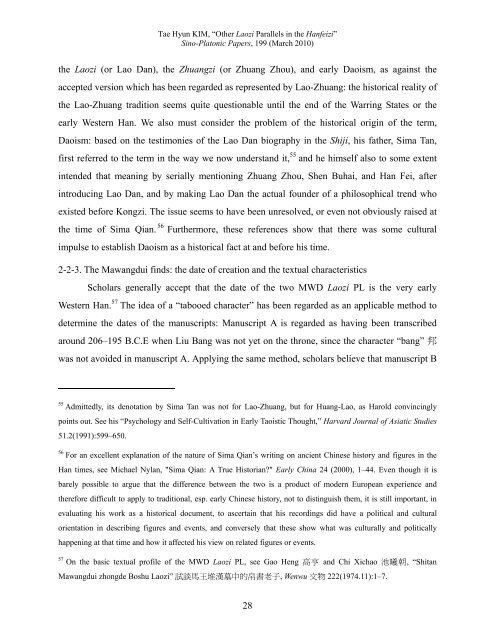Other Laozi Parallels in the Hanfeizi - Sino-Platonic Papers
Other Laozi Parallels in the Hanfeizi - Sino-Platonic Papers
Other Laozi Parallels in the Hanfeizi - Sino-Platonic Papers
You also want an ePaper? Increase the reach of your titles
YUMPU automatically turns print PDFs into web optimized ePapers that Google loves.
Tae Hyun KIM, “<strong>O<strong>the</strong>r</strong> <strong>Laozi</strong> <strong>Parallels</strong> <strong>in</strong> <strong>the</strong> <strong>Hanfeizi</strong>”<br />
S<strong>in</strong>o-<strong>Platonic</strong> <strong>Papers</strong>, 199 (March 2010)<br />
<strong>the</strong> <strong>Laozi</strong> (or Lao Dan), <strong>the</strong> Zhuangzi (or Zhuang Zhou), and early Daoism, as aga<strong>in</strong>st <strong>the</strong><br />
accepted version which has been regarded as represented by Lao-Zhuang: <strong>the</strong> historical reality of<br />
<strong>the</strong> Lao-Zhuang tradition seems quite questionable until <strong>the</strong> end of <strong>the</strong> Warr<strong>in</strong>g States or <strong>the</strong><br />
early Western Han. We also must consider <strong>the</strong> problem of <strong>the</strong> historical orig<strong>in</strong> of <strong>the</strong> term,<br />
Daoism: based on <strong>the</strong> testimonies of <strong>the</strong> Lao Dan biography <strong>in</strong> <strong>the</strong> Shiji, his fa<strong>the</strong>r, Sima Tan,<br />
first referred to <strong>the</strong> term <strong>in</strong> <strong>the</strong> way we now understand it, 55 and he himself also to some extent<br />
<strong>in</strong>tended that mean<strong>in</strong>g by serially mention<strong>in</strong>g Zhuang Zhou, Shen Buhai, and Han Fei, after<br />
<strong>in</strong>troduc<strong>in</strong>g Lao Dan, and by mak<strong>in</strong>g Lao Dan <strong>the</strong> actual founder of a philosophical trend who<br />
existed before Kongzi. The issue seems to have been unresolved, or even not obviously raised at<br />
<strong>the</strong> time of Sima Qian. 56 Fur<strong>the</strong>rmore, <strong>the</strong>se references show that <strong>the</strong>re was some cultural<br />
impulse to establish Daoism as a historical fact at and before his time.<br />
2-2-3. The Mawangdui f<strong>in</strong>ds: <strong>the</strong> date of creation and <strong>the</strong> textual characteristics<br />
Scholars generally accept that <strong>the</strong> date of <strong>the</strong> two MWD <strong>Laozi</strong> PL is <strong>the</strong> very early<br />
Western Han. 57 The idea of a “tabooed character” has been regarded as an applicable method to<br />
determ<strong>in</strong>e <strong>the</strong> dates of <strong>the</strong> manuscripts: Manuscript A is regarded as hav<strong>in</strong>g been transcribed<br />
around 206–195 B.C.E when Liu Bang was not yet on <strong>the</strong> throne, s<strong>in</strong>ce <strong>the</strong> character “bang” 邦<br />
was not avoided <strong>in</strong> manuscript A. Apply<strong>in</strong>g <strong>the</strong> same method, scholars believe that manuscript B<br />
55<br />
Admittedly, its denotation by Sima Tan was not for Lao-Zhuang, but for Huang-Lao, as Harold conv<strong>in</strong>c<strong>in</strong>gly<br />
po<strong>in</strong>ts out. See his “Psychology and Self-Cultivation <strong>in</strong> Early Taoistic Thought,” Harvard Journal of Asiatic Studies<br />
51.2(1991):599–650.<br />
56<br />
For an excellent explanation of <strong>the</strong> nature of Sima Qian’s writ<strong>in</strong>g on ancient Ch<strong>in</strong>ese history and figures <strong>in</strong> <strong>the</strong><br />
Han times, see Michael Nylan, "Sima Qian: A True Historian?" Early Ch<strong>in</strong>a 24 (2000), 1–44. Even though it is<br />
barely possible to argue that <strong>the</strong> difference between <strong>the</strong> two is a product of modern European experience and<br />
<strong>the</strong>refore difficult to apply to traditional, esp. early Ch<strong>in</strong>ese history, not to dist<strong>in</strong>guish <strong>the</strong>m, it is still important, <strong>in</strong><br />
evaluat<strong>in</strong>g his work as a historical document, to ascerta<strong>in</strong> that his record<strong>in</strong>gs did have a political and cultural<br />
orientation <strong>in</strong> describ<strong>in</strong>g figures and events, and conversely that <strong>the</strong>se show what was culturally and politically<br />
happen<strong>in</strong>g at that time and how it affected his view on related figures or events.<br />
57 On <strong>the</strong> basic textual profile of <strong>the</strong> MWD <strong>Laozi</strong> PL, see Gao Heng 高亨 and Chi Xichao 池曦朝, “Shitan<br />
Mawangdui zhongde Boshu <strong>Laozi</strong>” 試談馬王堆漢墓中的帛書老子, Wenwu 文物 222(1974.11):1–7.<br />
28
















